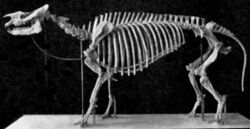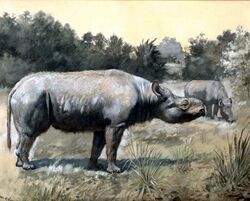Biology:Subhyracodon
| Subhyracodon | |
|---|---|

| |
| Subhyracodon occidentalis skeleton | |
| Scientific classification | |
| Domain: | Eukaryota |
| Kingdom: | Animalia |
| Phylum: | Chordata |
| Class: | Mammalia |
| Order: | Perissodactyla |
| Family: | Rhinocerotidae |
| Genus: | †Subhyracodon Brandt, 1878 |
| Type species | |
| Subhyracodon occidentalis | |
| Species[2] | |
| |
| Synonyms | |
Subhyracodon (Latin: "below" (sub), + Greek: "hyrax" (hyrak = 'shrewmouse'), and "tooth" (odontos, referring to the genus Hyracodon)[5]) is an extinct genus of hornless rhinoceroses. With a length of 2.4 m (7 ft 10 in) and a weight estimated of 381.3 kg (841 lb) (in S. mitis), it was a tapir-sized herbivore on the plains of early Oligocene South Dakota 33 million years ago (White River Fauna). It coexisted with other perissodactyls such as horses, brontotheres, and chalicotheres.[6] Subhyracodon had no horns, relying more on its speed to escape from predators, but a species found at Wind Cave National Park had a pair of bony nasal ridges. The genus Caenopus and species originally referred to as Aceratherium were synonymized into Subhyracodon.[7]
References
- ↑ Prothero, 2005, p. 41.
- ↑ Prothero, 2005, pp. 40-47.
- ↑ McKenna & Bell, 1997, p. 481.
- ↑ 4.0 4.1 4.2 Prothero, 2005, p. 43.
- ↑ "Glossary. American Museum of Natural History". https://research.amnh.org/paleontology/perissodactyl/concepts/glossary.
- ↑ "Paleobiology Database: Subhyracodon mitis". http://museumu03.museumwww.naturkundemuseum-berlin.de/cgi-bin/bridge.pl?a=basicTaxonInfo&taxon_no=51872.
- ↑ C.C. O'Harra (1920). The White River Badlands. Rapid City, SD: South Dakota School of Mines. pp. 181.
External links
Wikidata ☰ Q139803 entry



